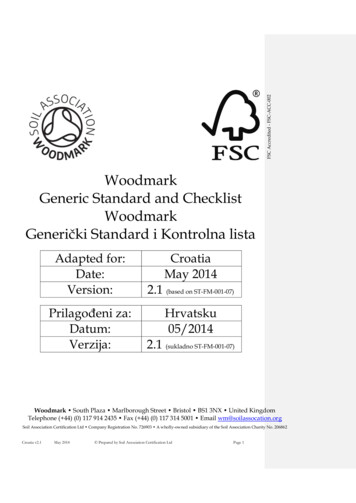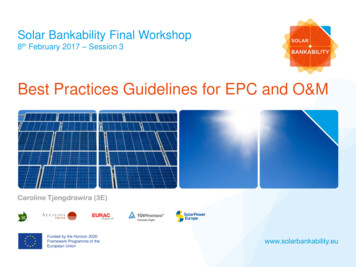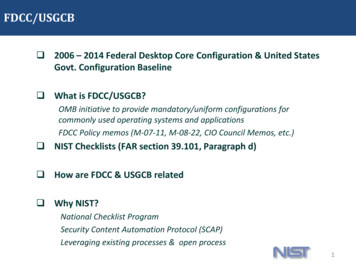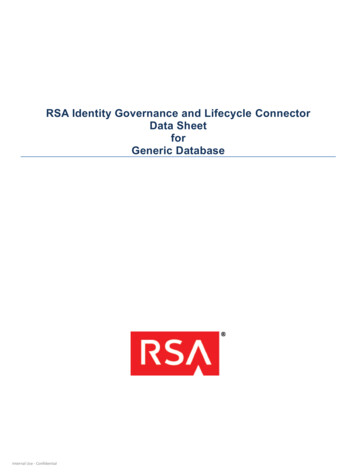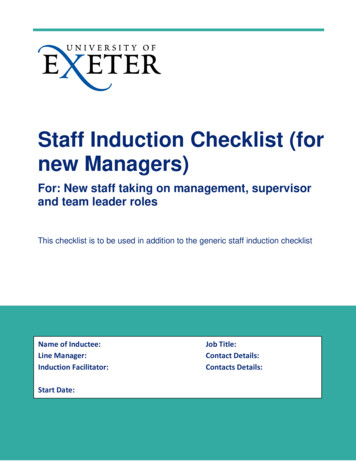
Transcription
FSC Accredited - FSC-ACC-002WoodmarkGeneric Standard and ChecklistAdapted for:Date:Version:KenyaMay 20143.1 (based on ST-FM-001-07)Woodmark South Plaza Marlborough Street Bristol BS1 3NX United KingdomTelephone ( 44) (0) 117 914 2435 Fax ( 44) (0) 117 341 5001 Email wm@soilassociation.orgSoil Association Certification Ltd Company Registration No. 726903 A wholly-owned subsidiary of the Soil Association Charity No.206862ST-FM-001-07 KEN v3.1May 2014 Prepared by Soil Association Certification LtdPage 1
ScopeThe Woodmark Generic Standard has been designed for use worldwide in FSC forest managementevaluations where there is no existing FSC accredited national standard.PurposeThis checklist has been designed to comply with FSC-STD-20-002 (v3.0; 2009) Structure, content andlocal adaptation of Generic Forest Stewardship Standards. .This checklist presents the Soil Association Woodmark Forestry Standard. The checklist has beendesigned for use: As the basis for development of a regionally specific standard, prior to a forest evaluation As the basis for self assessment by a forest manager or owner As the basis for a Woodmark scoping visit As the basis for a Woodmark evaluationLayout of the standard:The FSC Principles and Criteria of Forest StewardshipThe Standard is designed to follow the FSC Principles and Criteria for Forest Stewardship (FSC-STD-01001 (v4.0; 2002).The Standard is divided into 10 sections, each corresponding to one of the FSC principles. The principleitself is written across the top of each section in a grey shaded rows.Beneath each FSC principle the Standard lists each of the FSC criteria. The criteria are also in greyshaded rows, stretching across the first two columns of the table.The Woodmark StandardEach page of the table is divided into 4 columns.The first column lists all the Soil Association Woodmark indicators for a given FSC Criterion. Forexample, beneath FSC criterion 1.1 there are three Woodmark indicators, numbered 1.1.1, 1.1.2 and 1.1.3.The Woodmark indicators explain what the owner/manager has to achieve in order to fully meet theFSC criterion. The section on scoring, below, explains what happens if the manager meets some of theindicators but not others, only partially meets the indicators, or feels that the indicator is inappropriateor inapplicable.The second column lists ‘Verifiers’. Verifiers are simply elements of evidence that the inspector can useto verify that the Woodmark indicators are met. Sometimes the verifier is a document, such as a writtenpolicy or a map; sometimes the inspector can verify the indicator by talking to the forest manager, toworkers, or to other people involved with the forest enterprise; sometimes the inspector can verify theindicator by making an observation in the forest itself. The forest manager does not have to have all thedocuments mentioned as possible verifiers – the listed verifiers are just examples. If a particulardocument does not exist the inspector will look for another way of confirming that the criterion hasbeen met.The third column has several different purposes, depending on the purpose the generic standard isbeing used for. When the standard is being used as the basis for development of a regional standard, the thirdcolumn is used to record local or regional information and comments that will help tailor theST-FM-001-07 KEN v3.1May 2014 Prepared by Soil Association Certification LtdPage 2
standard to the particular region and situation it is being used in. For example, FSC Criterion 2.2refers to communities with legal or customary tenure. The local guidance column for the firstWoodmark indicator requests information about local communities that have customary or userights. This information will be annotated before a full inspection, and used to create a regionalversion of the standard for a specific forest evaluation. Parts of the standard may also be modifiedduring this process – where there is a regional consensus as to what constitutes good forestmanagement on some particular issue, or in a given situation. The only thing that cannot bechanged during this process of regionalisation is the FSC Principles and Criteria – these can only bechanged by FSC.An additional and important aspect of regionalisation is that stakeholders and the forest managerare provided with an opportunity to comment on the standard before the evaluation visit. Theforest managers’ comments will be considered at the same time as the comments of other consultees. When the standard is being used for self assessment by a forest manager or owner, the thirdcolumn can be used for recording the forester’s comments or questions. These might be notes aboutthe location of relevant documentation, or aide memoires to remind the manager how the particularindicator is met. The forest manager can also use this as the basis for comments or questions toWoodmark – for example to clarify what is meant by a particular indicator. The third column can also be used by the inspector during a pre-evaluation or ‘scoping’ visit. Inthis case the inspector will record observations in the column, and make notes about any aspects ofthe standard that the forest owner or manager does not comply with. The main gaps will then besummarised in a pre-evaluation report for the forester owner/manager. The inspector will also tryto record as much local information as possible during the visit, to help make a properlyregionalised standard for the full inspection visit. Finally, the third column is used by the inspector during a full evaluation to record theirobservations and comments. The inspector will be creating a record of what was seen or observedin order to verify a particular Woodmark indicator, whether anything was missing, or any otherinformation which is relevant to the inspection.The fourth column is only used for a full evaluation. The column is there for the inspector to provide a‘score’ for each Woodmark indicator, and each FSC Criterion. The scoring system is described below:ScoringThe Woodmark certification system is based on the recording of factual observations by the inspector,and secondly on the inspector’s professional judgement as to whether each Woodmark indicator andFSC Criterion has been met. However, Woodmark does not insist on perfection. There will be fewforest managers who can meet every one of the indicators consistently.For each Woodmark indicator, the inspector will mark the fourth column with the appropriate symbol(see key below):Y or Indicator has been met,N or x Indicator has not been met orNA the Indicator is not applicable in this situation.These marks do not have a rigid effect on the certification decision, but will show the general level ofcompliance and non-compliance.ST-FM-001-07 KEN v3.1May 2014 Prepared by Soil Association Certification LtdPage 3
The next stage is more important for coming to a decision. For each FSC criterion, the inspector willrecommend a score of between 1 and 5, on the following basis:1. Major Non-Compliance. Performance on the criterion as a whole does not constitute goodstewardship of the forest resource. There is either evidence of poor stewardship, or a significant riskthat problems will result if corrective action is not taken;A non-compliance shall be considered major if, either alone or in combination withfurther non-compliances of other indicators, it results in, or is likely to result in afundamental failure to achieve the objectives of the relevant FSC Criterion in the ForestManagement Unit(s) within the scope of the evaluation.continue over a long period of time, orare repeated or systematic1, oraffect a wide area, orare not corrected or adequately responded to by the forest managers once they have beenidentified.A Major non-compliance will generally result in a Pre-Condition or Major Condition.2. Minor Non-Compliance. The most important indicators of the criterion are met, but there areelements that should be improved to ensure that good stewardship is maintained in the long term;A non-compliance may be considered minor if:it is a temporary lapse, orit is unusual/ non-systematic, orthe impacts of the non-compliance are limited in their temporal and spatial scale, andprompt corrective action has been taken to ensure that it will not be repeated, andIt does not result in a fundamental failure to achieve the objective of the relevant FSC Criterion.A Minor non-compliance will generally result in a Condition or Observation.3. Compliance. A score of 3 is what would be expected from a well-managed enterprise of the size,type and complexity of the applicant. This level of achievement represents good forest stewardship.4. Strength. A score of 4 represents a particularly high level of performance for the criterion. A score of4 could be awarded when the forest management enterprise has had to overcome particularobstacles to achieve the level of performance shown, or scores particularly highly on some aspects ofthe criterion, though not on others.5. Strength. A score of 5 would be awarded for outstanding performance on a particular criterion. Ascore of 5 recognises outstanding merit in achieving the criterion, through innovative or state of theart management. A score of 5 could be awarded for technical, social or environmental aspects of themanagement.The certification body shall determine whether the number and impact of a series of minor non-compliancesidentified during sampling is sufficient to demonstrate 'systematic' failure (i.e. failure of management systems). Ifthis is the case then the repeated instances of minor non-compliances shall constitute a major non-compliance.1ST-FM-001-07 KEN v3.1May 2014 Prepared by Soil Association Certification LtdPage 4
FSCPrincipleExample of Inspector’s completed checklistFSC PRINCIPLE # 5: BENEFITS FROM THE FORESTForest management operations shall encourage the efficient use of the forest's multiple products and services toensure economic viability and a wide range of environmental and social benefits.SOIL ASSOCIATION arkIndicatorVERIFIER(S)FSC Criterion 5.1Forest management should strive toward economic viability, while taking into account the fullenvironmental, social, and operational costs of production, and ensuring the investments necessary tomaintain the ecological productivity of the forest.5.1.1 There is a work plan and budget for the forestAnnual budgetmanagement enterprise showing expected costs and revenuesfor at least the current financial year.COMMENTS andREGIONAL GUIDANCEOverall Score for Certification3Budget clearly set out, expected costsand revenues shown for two years5.1.2 The income predicted in the annual budget is consistentwith the expected rate of harvest of forest products (see 5.6).Product yields stated in annualbudget5.1.3 The income predicted in the annual budget is consistentwith product values comparable to regional or national normsProduct values stated in annualbudgetProduct values appear to besomewhat overestimated5.1.4 The annual budget incorporates stumpage, royalties orrents as required.Annual budgetRegional Guidance:royalties must be paid to the local forest departmentadministration on annual basis (see regulation FD4.511a 1989)Overall Score for CertificationFSC Criterion 5.2Forest management and marketing operations should encourage the optimal use and local processingof the forest's diversity of products.5.2.1 Forest managers make a proportion of their productionavailable to local enterprises, such as small-scale industries andprocessing operations, unless there is an over-riding reasonpreventing this.Sales informationDiscussion with local community(see 5.4 below for related indicators)score x4Clear management commitment forencouraging local processors withwritten strategy, several localcompanies already supplied withtimber. Overall Score for Certification2No recent purchase, no short termrequirements for extra machineryNA5.3.2 Timber is extracted and processed promptly after felling.Some evidence of wastage of timberat the road sideXInspectorsCommentsVerifiers5RegionalGuidance FSC Criterion 5.3Forest management should minimise waste associated with harvesting and on-site processingoperations and avoid damage to other forest resources.5.3.1 New on-site processing machinery is selected taking intoEvaluation of recent machineryaccount the need to minimise timber wastepurchasesNo evidence of wastage throughdelayed extraction or processingScore (forcriterion5.1)Inspectorsmark (forindicator5.2.1)
The basis for a certification decisionWoodmark will use the inspector’s recommended scores to come reach a certification decision.Firstly, a score of ‘1’ on any criterion normally represents a major non-compliance with theStandard, and requires some corrective action to be taken by the forest manager before acertificate can be awarded. Possible corrective actions may be discussed with the inspector, butultimately the inspector cannot provide definitive advice about what corrective action would besufficient to satisfy the requirements for certification. The inspector’s role is to identify theproblem; it is the forest manager’s role to find the solution.Secondly, a score of ‘2’ on any criterion normally represents a minor non-compliance, and willresult in either a recommended ‘condition’ for certification, or an ‘observation’. ‘Conditions’ arecorrective actions that the forest manager will be asked to implement within a set period of time(commonly 1 to 2 years). A certificate can still be issued, on the condition that the managermakes the corrective action within the specified time. Woodmark will check this at subsequentannual monitoring visits. An ‘observation’ does not require any corrective action on the part ofthe manager, but represents an area that will be looked at closely by inspectors on subsequentvisits.Thirdly, the scores for each FSC Principle will be added together and averaged. In order forWoodmark to issue a certificate the forest manager must have an average score of at least 3 (thelevel representing good forest stewardship) on each FSC principle. If the score on any principleaveraged less than 3, then Woodmark would not award a certificate even though no specific preconditions had been specified. This does not mean the forest enterprise has failed – but thatfurther work is required on that particular principle before a certificate can be issued. If themanager takes corrective actions within a reasonable length of time, then the Woodmarkinspector will carry out an inspection of the requirements for that Principle only, and ifperformance now averages 3 or more then a certificate can be issued.Where a single FSC criterion – e.g. criterion 6.2 – is itself subdivided, each subdivision will besummed and averaged to get a single figure for the criterion as a whole. It is this figure that willcontribute to the overall score for the Principle. However, a score of ‘1’ on a sub-criterion willstill be regarded as a major non-conformance, resulting in the issue of pre-condition tocertification.Review of inspector’s recommendations and scoresThe inspector’s recommendations are not final. Woodmark will only make its final certificationdecision after the inspector’s report has been reviewed by the applicant, and after the report hasalso been reviewed by our Peer Review Panel.We will take into account the comments of the forest manager, and the Peer Review Panel. Weare ready to discuss the pre-conditions, or conditions for issuing a certificate, and to clear up anyoutstanding issues. The scores recommended by the inspectors may be changed as a result ofthis process.Once we have done this we will finalise the certification evaluation report and finalise ourcertification decision.ST-FM-001-07 KEN v3.1May 2014 Prepared by Soil Association Certification LtdPage 7
SUMMARY OF SCORES FOR EACH FSCPRINCIPLEPrincipleScore12345678910SUMMARY OF SCORES FOR EACH FSC CRITERIONPrinciple 1CriterionScore1.11.21.31.41.51.6All Criteria with score of 1 or 2:Average for Principle 1Principle 2Criterion2.12.22.3All Criteria with score of 1 or 2:Average for Principle 2Principle 3Criterion3.13.23.33.4All Criteria with score of 1 or 2:Average for Principle 3ST-FM-001-07 KEN v3.1May 2014ScoreScore Prepared by Soil Association Certification LtdPage 8
Principle 4Criterion4.14.24.34.44.5All Criteria with score of 1 or 2:Average for Principle 4Principle 5Criterion5.15.25.35.45.55.6All Criteria with score of 1 or 2:Average for Principle 5Principle 6Criterion6.16.2a, 6.2b, 6.2c6.36.46.5a, 6.5b, 6.5c6.6a, 6.6b, 6.6c6.76.86.96.10All Criteria with score of 1 or 2:Average for Principle 6Principle 7Criterion7.1a, bi, bii, c, d, e, f, g, h,7.27.37.4All Criteria with score of 1 or 2:Average for Principle 7ScoreScoreScoreScorePrinciple 8ST-FM-001-07 KEN v3.1May 2014 Prepared by Soil Association Certification LtdPage 9
Criterion8.18.2i, ii, iii, iv8.38.48.5All Criteria with score of 1 or 2:Average for Principle 8Principle 9Criterion9.19.29.39.4All Criteria with score of 1 or 2:Average for Principle 9Principle .9All Criteria with score of 1 or 2:Average for Principle 10ST-FM-001-07 KEN v3.1May 2014ScoreScoreScore Prepared by Soil Association Certification LtdPage 10
FSC PRINCIPLE #1: COMPLIANCE WITH LAWS AND FSC PRINCIPLESForest management shall respect all applicable laws of the country in which they occur, and international treaties and agreements to whichthe country is a signatory, and comply with all FSC Principles and Criteria.SOIL ASSOCIATION WOODMARKVERIFIERINDICATORSFSC Criterion 1.1Forest management shall respect all national and local laws and administrative requirements.1.1.1 There is no evidence of outstanding claims of non-complianceConsultation with regulatorywith national and local laws and administrative requirementsauthorities and other interestedrelated to forest management.partiesNo evidence of non compliancefrom auditForest management policies andprocedures demonstratecompliance with relevantrequirements1.1.2 Forest managers demonstrate awareness of relevant codes ofpractice, guidelines or agreements.Discussion with forest managers1.1.3 There is no evidence of non-compliance with relevant codes ofpractice, guidelines or agreements.Discussion with forest managersCOMMENTS andREGIONAL GUIDANCEOverall Score for CertificationRegional Guidance: note relevantlaws and administrative requirements:Forests Act No. 7 of 2005Agriculture ActCo-operative ActLand Adjudication ActEnvironmental Management and Coordination ActWildlife ActCustomary LawsLabour LawsWater ActTimber ActForest Act’s General Rules (revised onannual basis) specifies pricing, fellinglicence /movement permit systemCo-operatives registered with theMinistry of Co-operative developmentForestry Management Guidelines existForest management policies andproceduresFSC Criterion 1.2All applicable and legally prescribed fees, royalties, taxes and other charges shall be paid.ST-FM-001-07 KEN v3.1May 2014 Prepared by Soil Association Certification LtdPage 11Overall Score for Certificationscore
1.2.1 Forest managers provide evidence that applicable fees,royalties, taxes and other applicable charges have been paid.ReceiptsAccountsNo evidence of non-paymentFSC Criterion 1.3In signatory countries, the provisions of all binding international agreements such as CITES, ILOConventions, ITTA, and Convention on Biological Diversity, shall be respected.1.3.1 Forest managers respect CITES provisions.Discussion with forest managersSpecies on CITES list are protected(see Annex 3)Export licences are available asrequired1.3.2 Forest managers implement appropriate controls to ensure that Discussion with forest managersILO provisions appropriate to their region are respected.Policies and proceduresImplementation of the following ILO conventions is a minimumSee Annex 5 for furtherrequirement for certification : 29, 87, 97, 98, 100, 105, 111, 131, 138,information on ILO conventions141, 142, 143, 155, 169, 182, ILO Code of Practice on Safety andHealth in Forest Work, Recommendation 135, Minimum WageFixing Recommendation, 1970.1.3.3 No child labour is usedST-FM-001-07 KEN v3.1May 2014ILO Conventions 138 & 182, ILODeclaration 1998, or equivalentnational legislation.Interviews with workers and theirlabour organisations or unionsRecords of labour inspectorateSite inspection Prepared by Soil Association Certification LtdPage 12Regional guidance: No royalties aredue for tree felling on own land.However if the harvested material is tobe moved from the FMU to anotherlocation a movement permit has to beacquired from the Kenya Forest Serviceat a fee.Overall Score for CertificationRegional Guidance: note local specieson CITES appendices 1 and 2 – seeannexRegional Guidance: note applicableILO conventions – see annexNote that a number of ILOconventions are addressed underprinciples 3, 4, 7As a general guide children under theage of 15 should not be employed (ILO138 article 3). National legislation mayrequire a higher minimum. Youngpeople under the age of 18 should not beemployed in potentially hazardousactivities such as pesticide application,harvesting, heavy work, work at night,unless there is special provision forsafety or traditional/communitycircumstances exist.
1.3.4 National minimum wage provisions are adhered to.1.3.5 There is no forced labour or debt bondage.1.3.7 Forest managers ensure that provisions of the Convention onBiological Diversity applicable in their region are respected.ILO Conventions 28 & 105, ILODeclaration 1998, or equivalentnational legislationInterviews with workers and theirlabour organisations or unionsRecords of labour inspectorateDiscussion with forest managersPolicies and proceduresInterviews with workers and theirlabour organisations or unionsRecords of labour inspectorateDiscussion with forest managersPolicies and procedures1.3.8 Forest managers implement appropriate controls to ensure thatother appropriate international agreements are respected.Discussion with forest managersPolicies and procedures1.3.6 Forest managers ensure that implications of ITTA provisionsappropriate to their region are respected.FSC Criterion 1.4Conflicts between laws, regulations and the FSC Principles and Criteria shall be evaluated for thepurposes of certification, on a case by case basis, by the certifiers and the involved or affected parties.1.4.1 Conflicts between laws, regulations and the FSC Principles and Discussion with forest managersCriteria are identified and evaluated by the forest managers, andbrought to the attention of the inspection team.Conflicts shall be assessed byWoodmark in co-operation withthe inspectors and involvedpartiesST-FM-001-07 KEN v3.1May 2014 Prepared by Soil Association Certification LtdPage 13Regional Guidance: is countrysignatory to ITTA? NoRegional Guidance: note implicationsof Convention on Biological Diversityin the regionKenya is signatory to Convention onBiological Diversity (see annex)Regional Guidance: note any otherapplicable international agreementsSee annex)Overall Score for CertificationNo obvious conflicts have been noted
FSC Criterion 1.5Forest management areas should be protected from illegal harvesting, settlement and otherunauthorised activities.1.5.1 The forest management unit is protected from harvestingSystems for protectionactivities and other activities not controlled by forest managers ordocumented.local people with use rights (e.g. settlement, illegal harvesting,No evidence of any ongoingpoaching).unauthorised activities.1.5.2 Systems to identify and prevent unauthorised activities are inSystems documentedplace.1.5.3 Managers have taken measures to stop illegal or unauthoriseduses of the forest.Discussion with managers1.5.4 The boundaries of the forest management unit are clearly defined onthe ground and marked on a map (draft FSC Kenya Standard 2008)i) The management plan ii)agreement document, iii) forestboundary map, and, iv) beaconsshowing forest boundaries on theground. (effective enforcementdemand legitimacy of the systems ie asystem or by-laws recognized by thecourts)FSC Criterion 1.6Forest managers shall demonstrate a long-term commitment to adhere to the FSC Principles andCriteria.1.6.1 Forest managers shall provide a documented statementWritten statement approved bydeclaring their long-term commitment to comply with FSCappropriate managementPrinciples and Criteria.personnelManagement Plan documentManagers display understandingof and commitment to FSCPrinciples and Criteria1.6.2 Forest managers shall declare any areas under their control but Discussion with managersnot included within the scope of the certification evaluation.Written declaration and list ofsites if applicable1.6.3 Forest workers are aware of the Owner’s or Managers’ Policy towards interviewsthe FSC P&C (Draft FSC Kenya Standard 2008)ST-FM-001-07 KEN v3.1May 2014 Prepared by Soil Association Certification LtdPage 14Overall Score for CertificationPlan for controlling illegal/unauthorised activities (draft FSCKenya standard 2008)Agreements between managers andstakeholders (draft FSC Kenyastandard 2008)Overall Score for CertificationNote need to evaluate against FSCpolicies on Partial Certification andExcision
FSC PRINCIPLE #2: TENURE AND USE RIGHTS AND RESPONSIBILITIESLong-term tenure and use rights to the land and forest resources shall be clearly defined, documented and legally established.SOIL ASSOCIATION WOODMARKVERIFIERINDICATORSFSC Criterion 2.1Clear evidence of long-term forest use rights to the land (e.g. land title, customary rights, or leaseagreements) shall be demonstrated.2.1.1 Legal ownership or tenure can be proved and is not subject toAbsence of significant disputesdispute.In the case of a dispute legaldocuments such as title deeds,lease agreement, or otherappropriate documentation areavailable for inspection.2.1.2 A map is available clearly showing legal boundaries orboundaries clearly demarcated on the ground (draft Kenya std2008)Maps2.1.3 Land is dedicated to long term forest management.Evidence that managementplanning plans for more than onerotationNo evidence of plans or activitiesthat would prevent long termforest managementST-FM-001-07 KEN v3.1May 2014 Prepared by Soil Association Certification LtdPage 15COMMENTS andREGIONAL GUIDANCEOverall Score for CertificationNote need to evaluate forest use rightsand record these here. These mayinclude: land title deeds (for alienatedprivate land, individually or companyowned), lease agreements (forgovernment,trust land and private rented forests),chief’s letter, or local authority landallocation letter (for non alienatedland).(draft Kenya std 2008)score
2.1.4 Communities have clear, credible and officially recognisedevidence, endorsed by the communities themselves, of collectiveownership and control of the lands they customarily own orotherwise occupy and use.ILO Convention 169 Art 14-17Interviews with local communityrepresentatives and indigenouspeoplesMaps demonstrating extent oftitled lands or recognisedterritoriesRecords in land cadasters and/orforestry departmentsFSC Criterion 2.2Local communities with legal or customary tenure or use rights shall maintain control, to the extentnecessary to protect their rights or resources, over forest operations unless they delegate control withfree and informed consent to other agencies.2.2.1 All legal or customary tenure or use rights to the forest resource - Discussion with managersof all local communities are clearly documented and mapped by theforest managers.- Consultation with localcommunity- Maps- Documentation of all rights ofway, use of common land, andusufructuary rights, etc.2.2.2 All legal or customary tenure or use rights to the forest resourceof all local communities are recognised and respected in forestmanagement planning and practice.ST-FM-001-07 KEN v3.1May 2014 Prepared by Soil Association Certification Ltd- Discussion with managers- Consultation with localcommunity representatives- Evidence in management plansand practicesPage 16customary rights as listed in managementplan (for private, gazettedforest reserves and trustland forests) (draftKenya std)Overall Score for CertificationRegional guidance: identify localcommunities that have customarytenure or use rights in the area:Under Customary Law, if no officialtitle is held there is a system wherebythe Chief can ascertain ownership ofland and can grant official ownershipto the occupier.Under Agriculture Act, even if land isnot owned, trees will be owned byoccupiers.
2.2.3 Forest managers provide local communities control over forestoperations to the extent necessary to protect their rights andresources.- Existence of formal consultativecommittees and procedures- Consultation with localcommunity representatives- Free and informed consentexpressed by communityrepresentatives- Absence of significant disputes- Documentary evidence ofagreements- No evidence of restrictionsimposed by forest managerswithout community consent- Appropriatepayment/compensation for forestresource use.FSC Criterion 2.3Appropriate mechanisms shall be employed to resolve disputes over tenure claims and use rights.The circumstances and status of any outstanding disputes will be explicitly considered in thecertification evaluation. Disputes of substantial magnitude involving a significant number ofinterests will normally disqualify an operation from being certified.2.3.1 Mechanisms exist for resolution of disputes between theConsultation with local communityforest managers and the local community over claims relating torepresentativestenure and/or use rights.ST-FM-001-07 KEN v3.1May 2014 Prepared by Soil Association Certification LtdPage 17Regional Guidance: In countrieswhere local communities are lessphysically dependent on forests butvalue the forest for aesthetic, spiritualor recreational reasons, consult
Verifiers are simply elements of evidence that the inspector can use to verify that the Woodmark indicators are met. Sometimes the verifier is a document, such as a written policy or a map; sometimes the inspector can verify the indicator by talking to the forest manager, to . Woodmark - for example to clarify what is meant by a particular .
